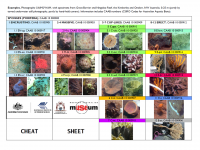Home > Biology and biodiversity > Seafloor > Seabed benthos: Epibenthic sled data > Sponge functional growth forms as a means for classifying sponges without taxonomy
Sponge functional growth forms as a means for classifying sponges without taxonomy
- Christine Schönberg
- Australian Institute of Marine Science

Christine Hanna Lydia Schönberg (AIMS), Jane Fromont (WAM)
Sponge taxonomy is difficult and challenging, it requires adequate laboratory facilities, experience and time, which are often not available. Moreover, not all habitats can be physically sampled (e.g. protected areas, deep sea), and for monitoring purposes video work is usually the preferred method. However, sponges cannot reliably be identified from imagery lacking samples, and therefore we recommend using growth forms as a quick classification. If the growth forms are described by clearly focusing on their function, they will represent environmental conditions, e.g.
• turbulence and crashing waves will select for crusts and cryptic sponges,
• stagnant waters for separation of inhalant and exhalant streams as is typical in e.g. barrels,
• laminar forms provide information about prevailing currents, and
• sedimentation will favour erect and cryptic-massive forms.
The idea behind this classification is therefore the function, not always the growth morphology. E.g. a crust around a thinly erect substrate such as a gorgonian becomes a ‘simple-erect’ growth form and a ball on a gorgonian a ‘stalked’ form, endolithic bioeroding sponges and creeping forms are here classified as crusts, even if they are truly massive or branching along the surface, while layered ‘kebap’ sponges and massive sponges with many large holes and complex forms may sometimes function as ‘branching’ sponges. Lattice-like laminar sponges with holes count as ‘palmate’ and are scored together with hand-shaped sponges, i.e. having branches in one plane. There are many, many intermediate forms that make decisions difficult. Focus on the function for any given situation to choose a morphology.
The system we developed was adjusted and corrected over 4 years and tested by us in different field situations around Australia, including the Great Barrier and Ningaloo Reefs, and Kimberley and Pilbara coasts. By providing access to draft versions, we were able to obtain feedback from user groups such as the Geoscience Australia, CSIRO and AIMS monitoring teams, and we introduced the final version during a workshop after the 2013 9th World Sponge Conference to a wide range of people working on sponges (students, established scientists, agencies and industry; highly qualified taxonomists who work on specimens to ‘amateur’ surveyors working with imagery). The current product has assimilated all feedback. If the scheme becomes widely used, comparisons between different studies become possible, as well as large-scale application. Following the proposed system for sponges, scoring can be done at different levels, depending on the questions and available resources:
• It is possible to score ‘attached benthos’, ‘filter feeders’ or ‘sponges’ as a group. This was largely the standard before this classification, and we would like to move beyond it.
• Distinction at the coarsest level provides basic information and identifies 4 groups: functional crusts, functional massives, functional cups and functional erect forms.
• The next level recognises 12 different forms: functional crusts, simple-massive forms, balls, cryptic massive forms, shallow sponges with large surface areas (tables through to cups), barrels, tubes, fans, 2-dimensional hand-shaped and lattice-like forms, 3-dimensionally branching forms, whips and columns, and stalked forms. From our experience this level provides the best balance between effort and output, and we regard it as suitable for field surveys, environmental assessment and monitoring.
• At a third level, the functional crusts (light blue block) can further be divided into creeping and endolithic forms and true crusts, and the cups (green block) can be divided into forms resembling discs or tables, incomplete cups and shallow cups. The more detail is applied using the classification, the better characterised the community, but this requires more effort.
• Any further distinctions can be added to suit individual needs (colours, size, photosynthetic status, intermediate forms, surface characteristics etc.). At this finest level this will prevent comparison with other studies using this scheme that do not include this additional detail. However, such studies can still be compared at coarser levels if they follow the system provided here.
This information is summarised on the ‘cheat sheet’ available below. This document can be downloaded as PDF, printed, trimmed and laminated, to be used during fieldwork.







